Introduction
The agricultural sector has a great impact on the Brazilian economy. In fruit growing, the citrus industry is considered one of the most important sectors; however, it has innumerable problems in the production chain, especially in the production of seedlings, since this requires adequate quality, health guarantees and root growth (Schafer, Bastianel, & Cunha-Dornelles, 2001).
Greenhouse seedling production requires technological improvements that help control environmental factors (solar radiation, temperature, humidity, etc.), in addition to suitable pots, substrates, inputs and management. Of these latter requirements, the physical, chemical and biological properties of the substrates are fundamental, as they are directly related to the development of the seedlings in the orchard (Fleig-Saidelles, Winckler-Caldeira, Nagel-Schirmer, & Vigan-Sperandio, 2009; Winckler-Caldeira, Nunes-da Rosa, Bergamo-Fenilli, & Pamplona-Harbs, 2008). The cultivation of plants in protected environments demands large quantities of quality substrates, which ensure production both in the seedbed and in the nursery (Spier, Silva-da Silva, Schafer, & Dutra-de Souza, 2009). Substrates may be of synthetic, mineral or organic origin; most are of organic origin, made from materials such as coconut fiber (Malvestiti, 2004), carbonized rice husks (Guerrini & Trigueiro, 2004) and Pinus bark, among others.
In southern Brazil, there are companies that produce substrates; however, they do not always meet producers’ needs, so their chemical and physical characteristics need to be adapted to meet market demands (Fermino & Kämpf, 2012). According to Schafer, Dutra-de Souza, and Sidnei-Fior (2015), most of the substrates analyzed from southern Brazil have alkaline pH, an undesirable characteristic due to the fact that it affects the availability of some micronutrients. Additionally, high electrical conductivity values can cause productive losses due to salinization resulting from the use of non-stabilized products derived from animal excretion.
Although there are some suitable substrates for plant production, there is a constant search for low-cost materials that are available year-round. The seasonality observed in the supply of organic substrates is directly related to the harvesting and product consumption periods, which present demand for substrate and residues, respectively.
The cultivation of Pinus sp. generates a large amount of leaf litter, which inhibits the development of other species in the forest due to the allelopathic effect of the green needles and mulch formation (Schumann, Little, & Eccles, 1995). The accumulation of needles also causes the proliferation of pests, since they serve as protection, facilitates the spread of fires (Bolzon-Muñiz et al., 2014) due to the high calorific power (11.96 MJ·kg-1) of this material (Thörnqvist, 1985) and acidifies the surface of the leaf litter (Schumacher, 2002), the last of which can be used in substrate conditioning.
Therefore, and due to the need to produce quality citrus rootstocks in greenhouses, the objective of this work was to evaluate the effect of substrates composed of Pinus sp. needles and a commercial alkaline substrate, at different concentrations, on the growth and development of Poncirus trifoliata (L.) Raf. rootstock.
Materials and methods
The study was conducted at the Universidade Federal do Rio Grande do Sul (EEA/UFRGS) in Eldorado do Sul. The rootstock (Poncirus trifoliata [L.] Raf.) was transplanted in a greenhouse, when it averaged 5.4 cm, into polyethylene bags (useful volume of 5 L) with different concentrations of Pinus needle substrate (0, 25, 50, 75 and 100 %) that had one year of in situ composting, and a commercial substrate based on eucalyptus bark developed by a company located in the city of Eldorado do Sul (Rio Grande do Sul, Brazil).
The needles were collected from the leaf litter of a forest located in the Agricultural Experimental Station of the same university. After harvesting, they were dried at 25 °C, ground in a mill and separated by particle size (3.5 and 8.0 mm). On the other hand, the commercial substrate had a pH of 8.1 ± 0.5, electrical conductivity (EC) of 0.95 ± 0.3 mS·cm-1, water retention capacity (WRC) of 45 % and dry density (DD) of 450 kg·m-3.
The plants were kept in polyethylene bags on aluminum tables and watered by a drip irrigation system operated by an electronic timer that supplied 3 mm·plant-¹·day-¹. This volume was adapted considering evaporation loss and plant absorption, replenishing from 100 to 125 %; this made it possible to leach salts, thereby reducing the risk of substratum salinization in summer. In addition, 50 mL·plant-1 of a nutrient solution containing ammonium sulfate (5 g·L-1) and Multi NPK Cristalline (13-2-44) (2 g·L-1) were supplied manually on a biweekly basis starting 90 days after transplanting.
The pH and EC were monitored every 15 days using the non-destructive Pour Thru method (Cavins et al., 2000). Vegetative development was evaluated from the height (from the neck to the apex) and the diameter of the neck of the plants. At the end of the study, the number of leaves per plant (NLP) was counted and the leaf area per plant (LAP) was determined with a LI-Cor® leaf area meter (model LI-3100). The average per leaf was obtained by dividing the LAP by the NLP. In addition, the dry mass of leaves, stem and roots per plant was determined after drying them to constant weight in an oven at 65 °C. Root ball stability was evaluated by means of a scale from 1 to 5, where 1 is the absence of a root ball, 3 the formation of ½ a root ball and 5 a perfect root ball.
A randomized block experimental design under a factorial scheme with ten treatments and four replications was used. Each experimental unit consisted of seven plants. The employed treatments were 0, 25, 50, 75 and 100 % Pinus needles, under two particle sizes (3.5 and 8.0 mm), in a mixture (v:v) with a commercial substrate of eucalyptus bark.
The data were subjected to an analysis of variance in Costat 6.4 software, and a polynomial regression using SigmaPlot 11.0 (P ≤ 0.05). The fresh mass data of the aerial part and leaf area were transformed to 1/x and log(x/10), respectively.
Results and discussion
The particle size of the Pinus sp. needles did not influence the pH of the substrate; however, the needles maintained their acid pH during the development of the rootstocks, in addition to providing acidity to the substrates formulated with the greatest proportion of this material (Figure 1). This relationship was maintained during the development of the crop, but decreased at the end of the study; this was due to the chemical characteristics of the Pinus needles, which have acidity values between 4.2 and 6.2 depending on the decomposition of the material.
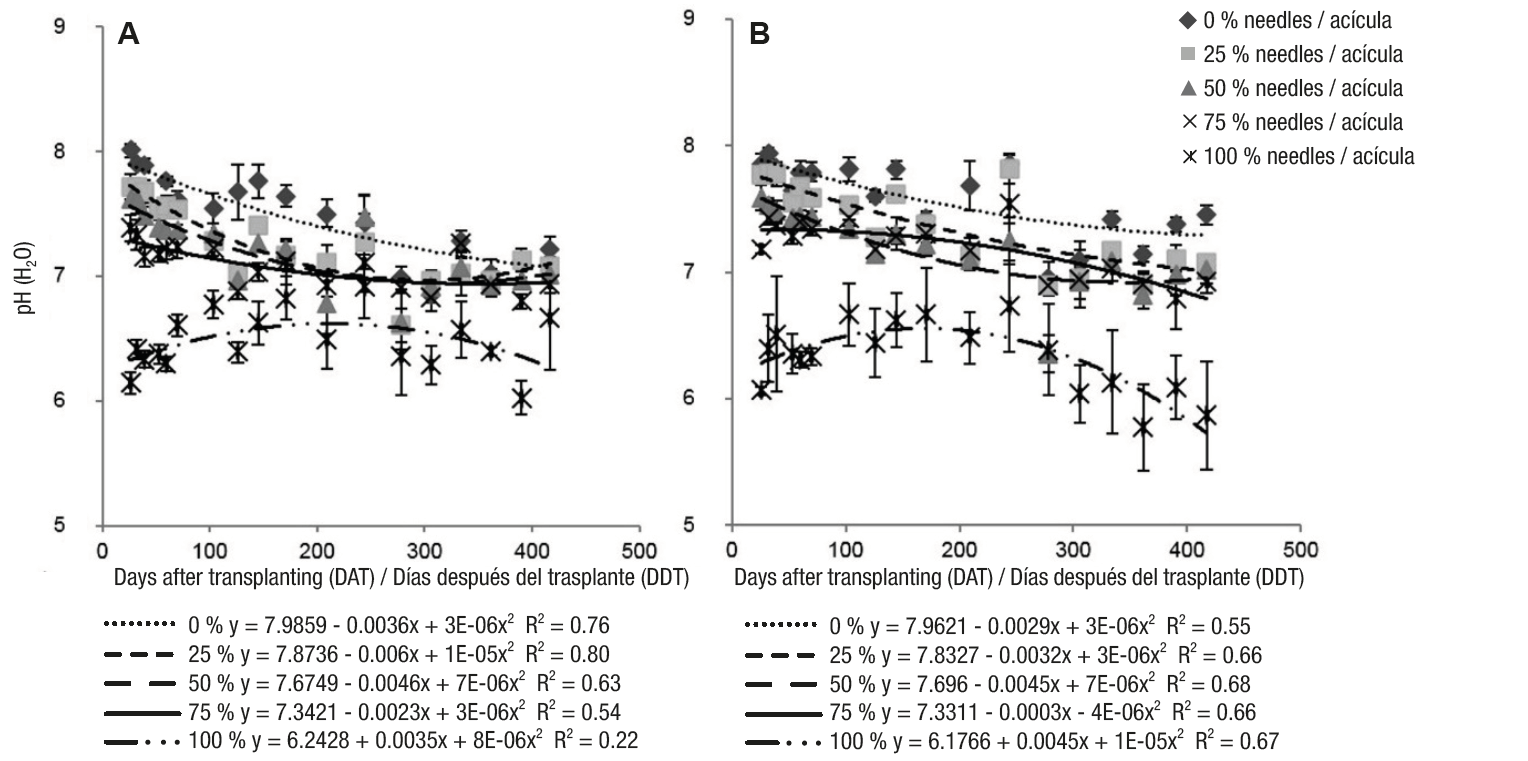
Figure 1 Variation in pH after cultivation of Poncirus trifoliata rootstock in substrates with a mixture of different proportions of Pinus sp. needles and commercial substrate based on eucalyptus bark. Porto Alegre, 2015. Particle size: A = 3.5 mm and B = 8.0 mm.
According to Cavins et al. (2000), the pH variation in the culture medium in all treatments could be due to several factors, such as the initial components and alterations in the substrates, including liming, fertilizer, irrigation water quality and cultivated species, among others. Additionally, variation was observed in irrigation water pH (from 5.43 to 7.4), which could influence the pH increase in the treatment with 100 % needles. Another factor that could have contributed to the change in this parameter is the fertilization with ammonium sulfate, due to its acid reaction (Mello et al., 1980), thereby contributing to the acidification of the medium.
The Pinus needles have low EC, which is considered an excellent characteristic for their use as substrate, since in this way the source of nutrients for the crop comes from the medium (Kämpf, 2004) and can be provided based on crop needs. In this context, it was observed that on day 26 the treatments containing the highest proportion of needles had the lowest EC values, compared to the 0 % treatment (Figure 2).
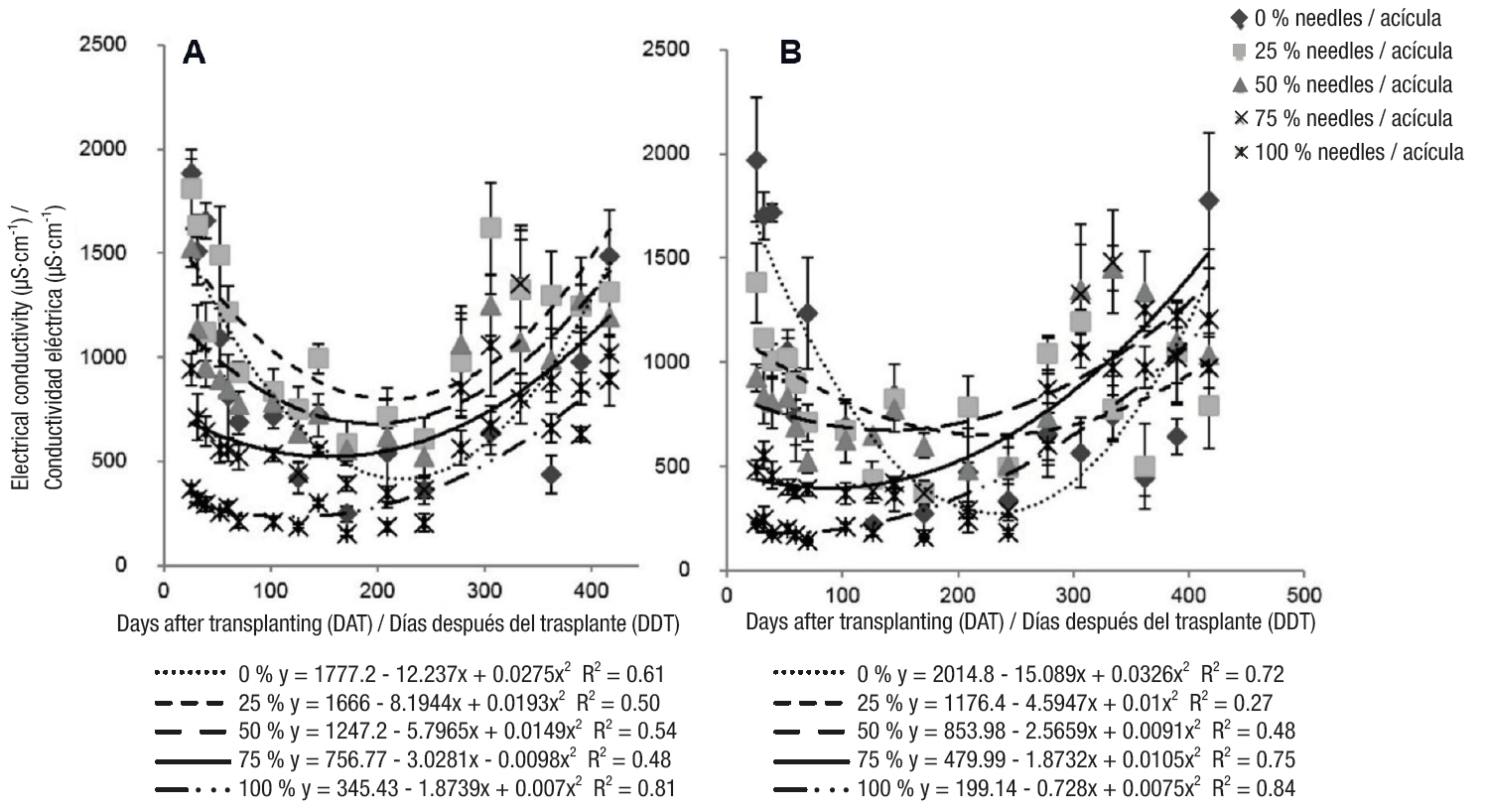
Figure 2 Variation in electrical conductivity after cultivation of Poncirus trifoliata rootstock in substrates with a mixture of different proportions of Pinus sp. needles and commercial substrate based on eucalyptus bark. Porto Alegre, 2015. Particle size: A = 3.5 mm and B = 8.0 mm.
The EC results obtained in this study may be related to fertilization, which started 100 days after transplanting; this fertilization was intentionally delayed to evaluate the fertility of the substrates. It was detected that the higher the initial EC of the treatments, the greater the losses. Thus, fertilization should be carried out using smaller and more frequent doses, thus reducing excessive losses due to leaching. Bueno-Scivittaro, Pedroso-de Oliveira, and Radmann (2004) found that slow-release fertilizers accelerate the development of 'Trifoliata' rootstock if 6 kg·m-³ is applied on a commercial substrate consisting basically of eucalyptus bark.
Regarding the dry density of the substrates, the Pinus needles had a lower density than the commercial substrate. Therefore, the treatments with a higher needle percentage were less dense (Figure 3). Additionally, all the mixtures maintained their density during cultivation, which indicates a stability in the particles, a desired characteristic in substrates.
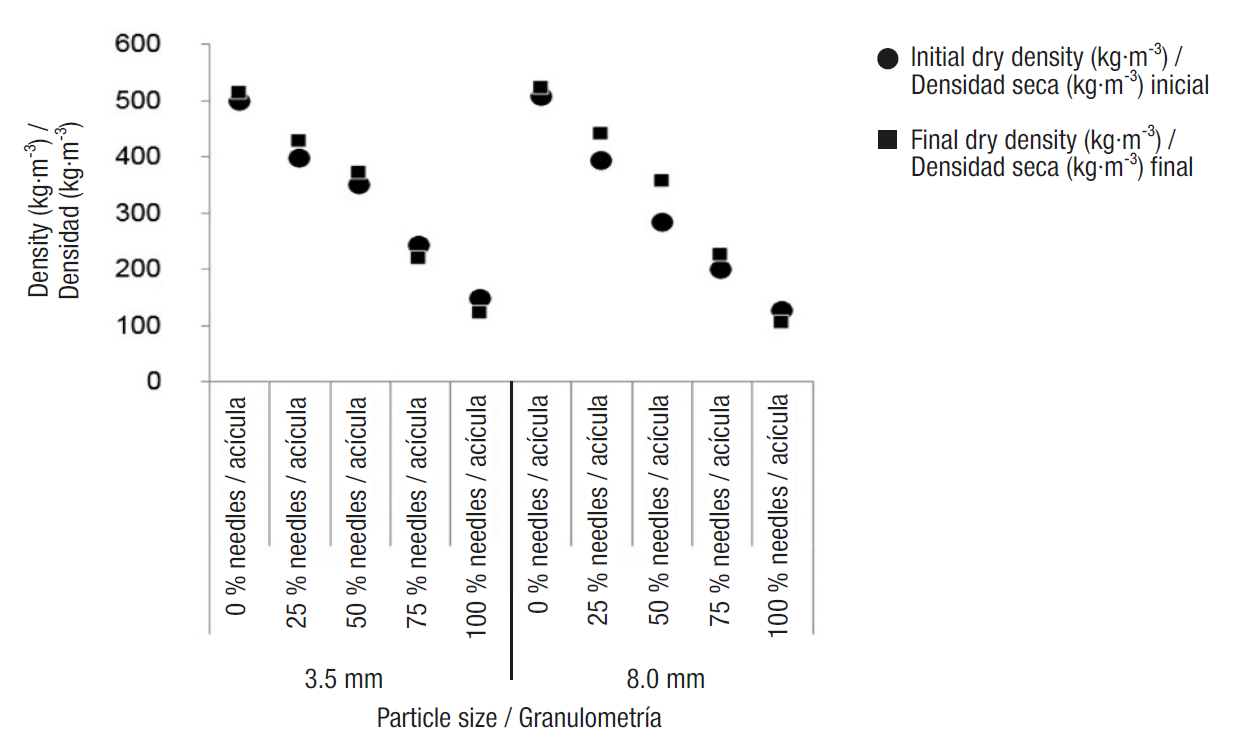
Figure 3 Variation in initial (day 0) and final (417 days after transplanting) dry density of substrates with a mixture of different proportions of Pinus sp. needles and commercial substrate based on eucalyptus bark in the cultivation of Poncirus trifoliata seedlings. Porto Alegre, 2015.
As for the evaluation of the physical characteristics of the mixtures during culture, there was a small variation in the percentage of solids, air space, available water, accumulated water and remnant water in the treatments with 3.5 mm needles (Figure 4A). In this way, the stability of the material was verified. On the contrary, the treatments formulated from 8.0 mm needles presented instability, since they showed greater variation in the aforementioned physical characteristics (Figure 4B). This behavior is due to several factors: the arrangement of particles, the decomposition of non-stabilized materials, the compaction of the substrate, the release of root exudates and the establishment of microorganisms in the organic material.

Figure 4 Percentage of solids, air space (AS), available water (AvA), accumulated water (AcW) and remnant water (RW) in mixed substrates of different proportions of Pinus sp. needles and commercial substrate based on eucalyptus bark, in the cultivation of Poncirus trifoliata seedlings. Porto Alegre, 2015. Particle size: A = 3.5 mm and B = 8.0 mm.
Although the substrates physically changed throughout the culture, this did not affect the development of the citrus rootstock. Height was similar among treatments with the same needle ratio (v:v), regardless of particle size (3.5 or 8.0 mm; Figure 5). This can be explained by the similarity of the EC among these treatments. According to Bueno-Scivittaro et al. (2004), fertilization greatly influences the development of Poncirus trifoliata (L.) Raf.
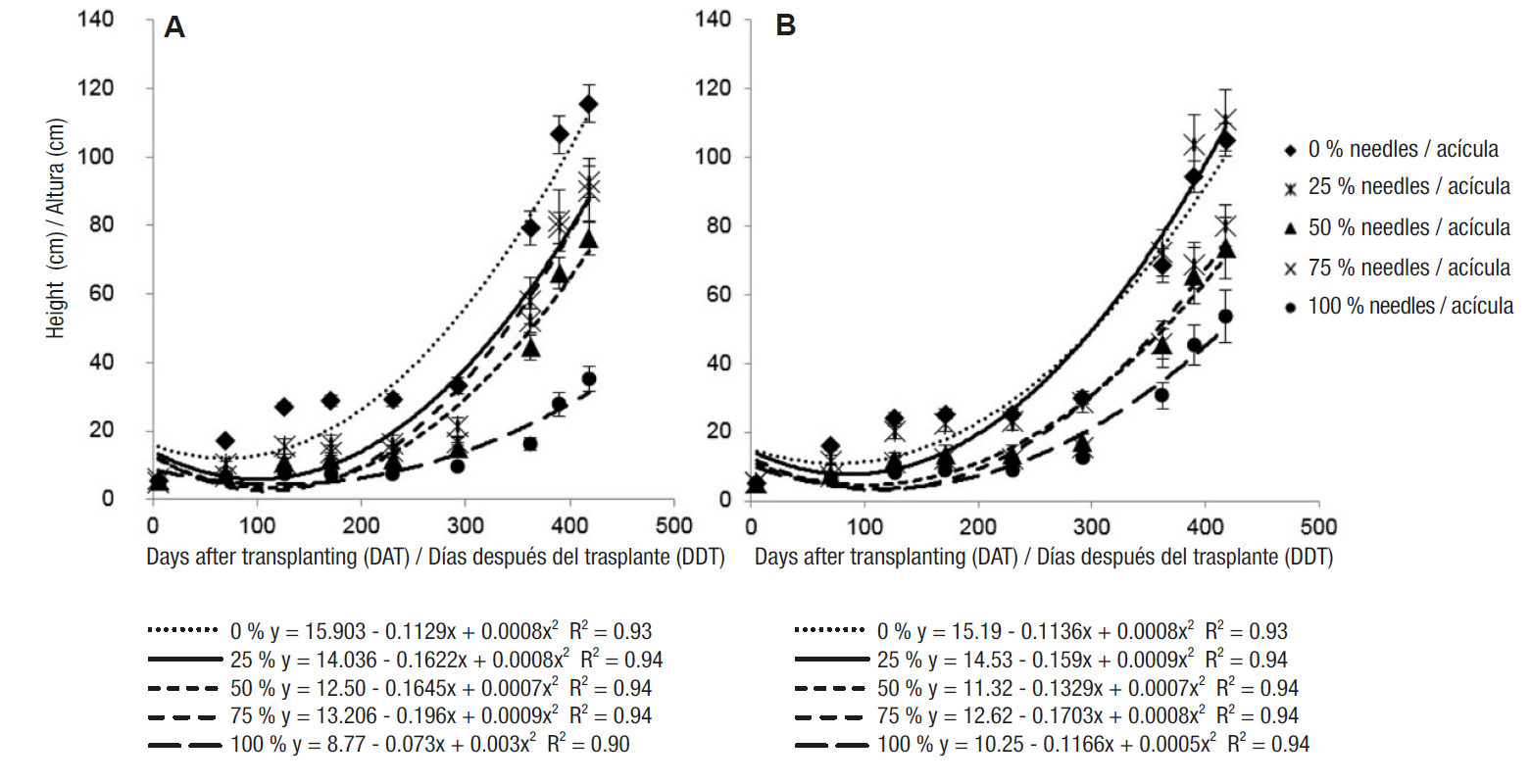
Figure 5 Height of Poncirus trifoliata seedlings grown on mixed substrates of different proportions of Pinus sp. needles and commercial substrate based on eucalyptus bark. Porto Alegre, 2015. Particle size: A = 3.5 mm and B = 8.0 mm.
During crop development, higher height occurred in those Poncirus trifoliata (L.) Raf. plants cultivated on commercial substrate based on eucalyptus bark alone or with 25 % needles, regardless of particle size (Figure 5); this could be due to the higher EC of the substrates with a lower needle percentage (Figure 3). Thus, if the same fertility conditions of the substrates are maintained throughout the entire production process, treatments with a higher percentage of Pinus needles would probably not be inappropriate.
The diameter of the neck of the plants showed a behavior similar to that which occurred with height. From the regression analysis, a reduction in the diameter of the 'Trifoliata' rootstock was detected as the percentage of needles in the mixture increased, regardless of the size used (Figure 6). In this same parameter, the treatment containing only commercial substrate was superior to those with needles in their different concentrations, as a consequence of their higher initial fertility. Decarlos-Neto, Siqueira-de Lopes, Pereira-Gomes, and Alvarez (2002), with increasing doses of nitrogen fertilizer, reported greater height and diameter in different rootstocks grown in pots. However, nitrogen doses higher than 3,000 mg·dm-³ caused a negative effect on plant growth.
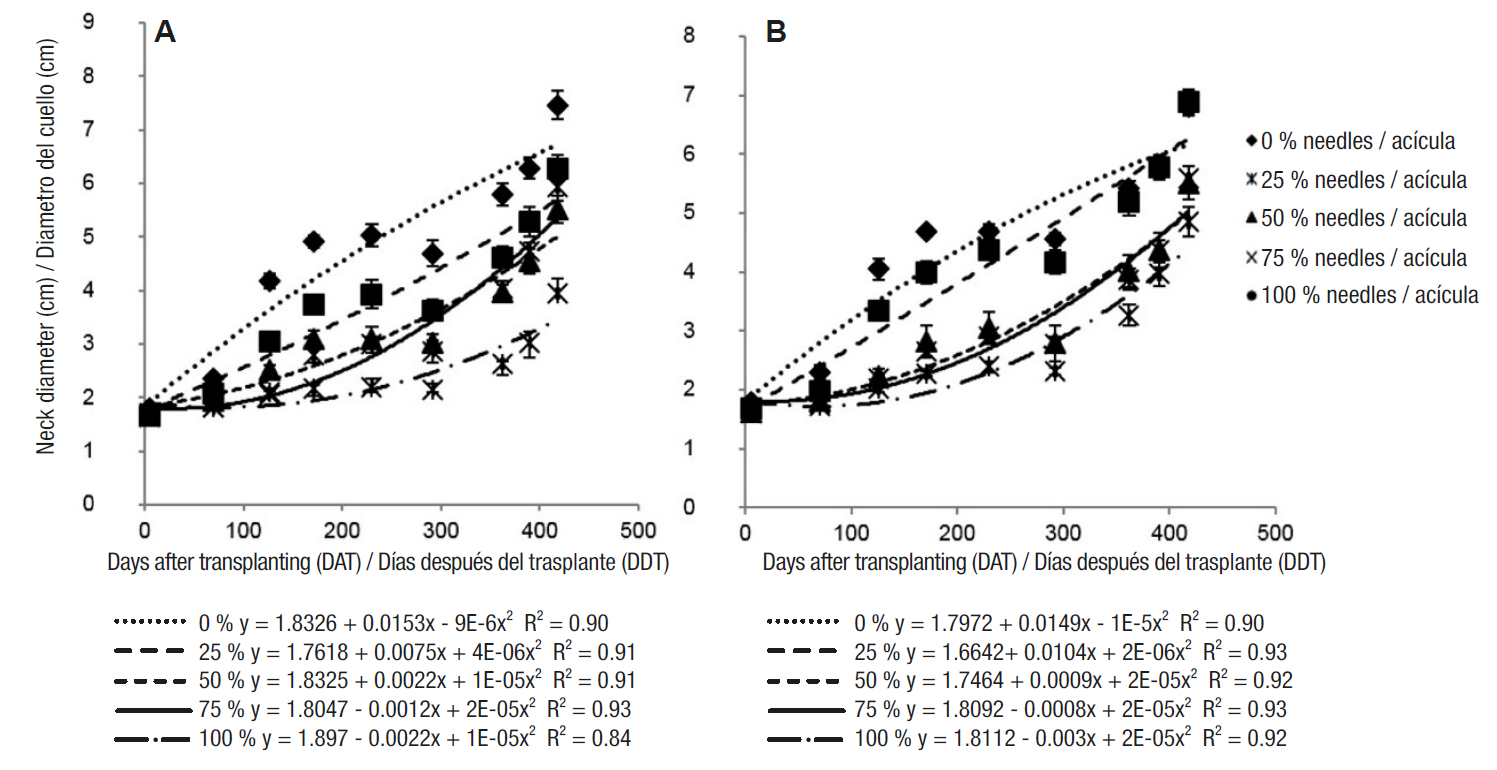
Figure 6 Neck diameter of Poncirus trifoliata seedlings grown on mixed substrates of different proportions of Pinus sp. needles and commercial substrate based on eucalyptus bark. Porto Alegre, 2015. Particle size: A = 3.5 mm and B = 8.0 mm.
Diameter is an important parameter in nurseries, since its accelerated growth means earlier grafting and, therefore, the production of seedlings in less time (Souza & Schafer, 2006). In Rio Grande do Sul, the time needed for rootstocks to be ready for use can be up to one year, varying according to the climate and cultivation system (Mendes-de Oliveira, da Silva-Rodrigues, Loyola-Dantas, Soares-Filho, & Girardi, 2014). In this sense, other propagation processes such as staking usually accelerate the process (Mourão-Filho, Girardi, & Zarate-do Couto, 2009).
Regarding the dry weight of the rootstock, the stems showed higher values, followed by the roots and leaves (Figure 7). Schafer, Dutra-de Souza, Koller, and Schwarz (2006) found greater accumulation of dry weight in roots than in the aerial part, which differs from the values found in this work. Due to the difference in results, it was proven that the growth of the plant is directly related to the fertility of the culture medium. Treatments with higher fertility at the beginning of the experiment accelerated the growth of the plants, causing the accumulation of dry matter both in the root and in the aerial part.
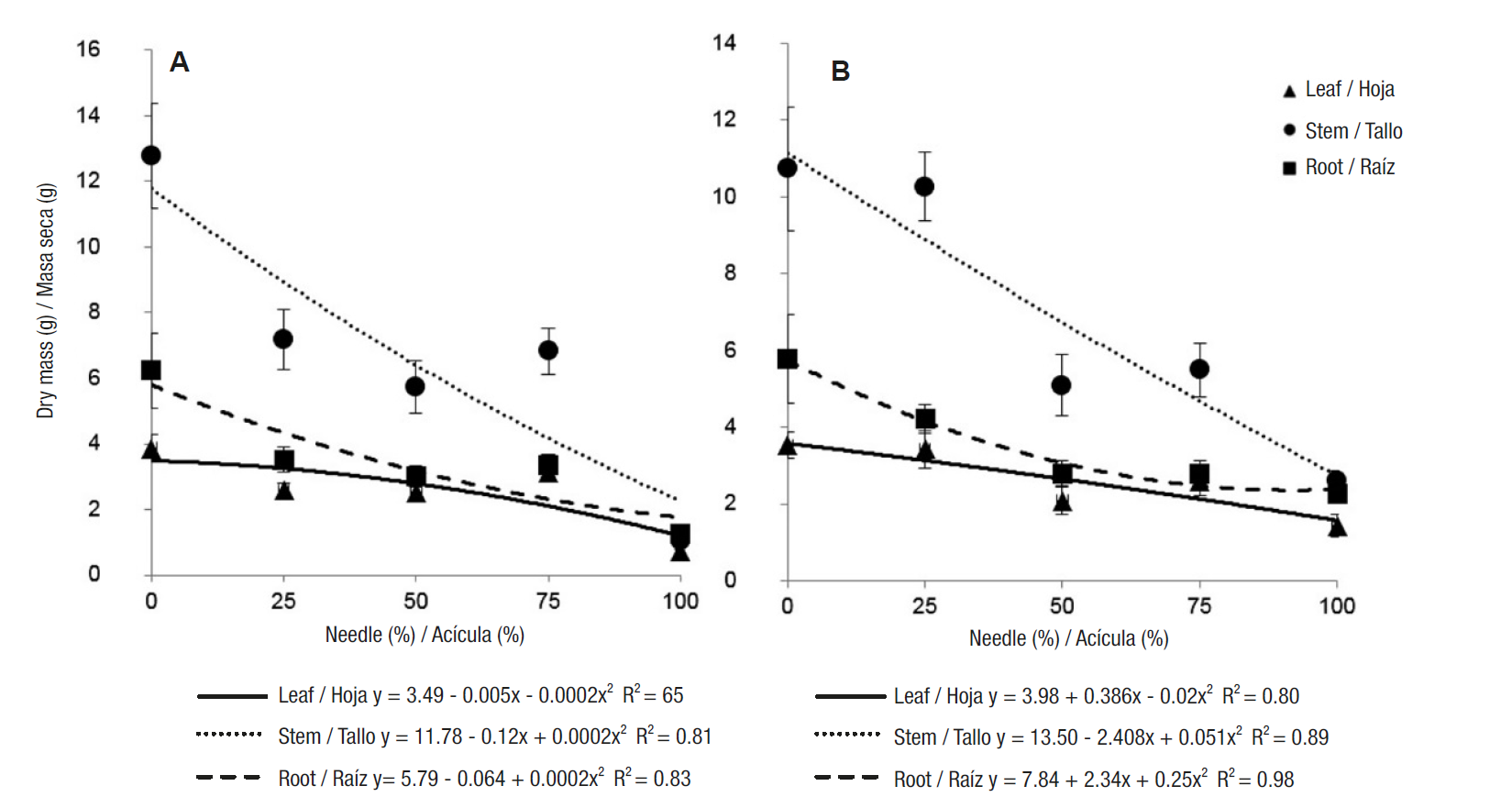
Figure 7 Dry weight of Poncirus trifoliata seedlings grown on mixed substrates of different proportions of Pinus sp. needles and commercial substrate based on eucalyptus bark. Porto Alegre, 2015. Particle size: A = 3.5 mm and B = 8.0 mm.
The average values obtained for number of leaves per plant, leaf size and leaf area corroborate the lower development of plants cultivated in substrates with low EC.
The consistency of the root ball was lower in the treatment with 100 % Pinus needles; the rest of the treatments had values superior to four, regardless of particle size. The deficient formation of the root ball in the substrate caused less development of the plants and, consequently, less growth and root dry weight; in addition, the greater aeration space decreases the cohesion between the solid particles.
Based on the results obtained in this study, the potential for the use of Pinus sp. needles as alkaline substrate conditioners was determined. The chemical, physical and biological characteristics of this material make it a favorable input in the development of new culture media. Thus, there is support for the idea of using needles in mixtures with alkaline substrates, as they promote the development of 'Trifoliata' rootstock when used in proportions of up to 25 %.
In treatments with a higher percentage of needles, the results were not satisfactory, since the handling given to them favored the commercial substrate; therefore, it is necessary to balance the fertility of the substrates in order to minimize the effect of the EC, as this is one of the determining characteristics in the development of citrus rootstocks.











 texto en
texto en 


